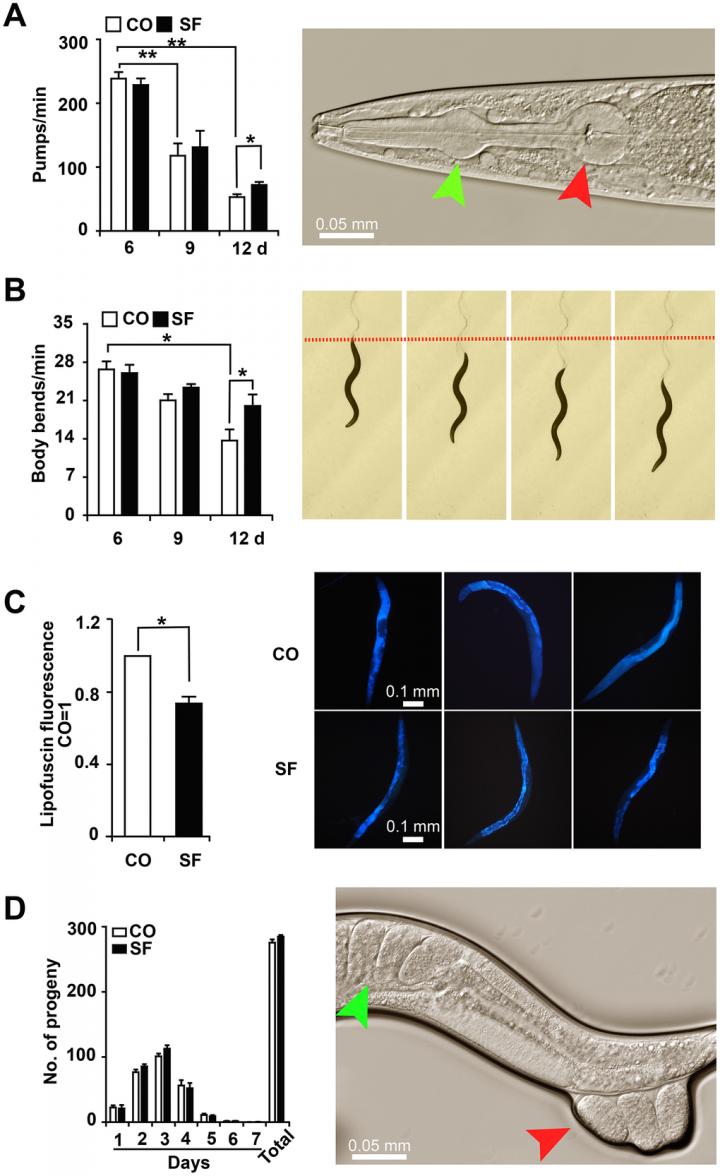‘The results in this Aging-US research output, indicate that sulforaphane prolongs the lifespan and healthspan of C. elegans through insulin/IGF-1 signaling’

Credit: Correspondence to: Ingrid Herr email: [email protected]
Aging-US published “Sulforaphane promotes C. elegans longevity and healthspan via DAF- 16/DAF-2 insulin/IGF-1 signaling” which reported that the broccoli-derived isothiocyanate sulforaphane inhibits inflammation, oxidative stress and cancer, but its effect on healthspan and longevity are unclear.
The authors used the C. elegans nematode model and fed the wildtype and 9 mutant strains ±sulforaphane.
Sulforaphane increased the lifespan and promoted a health-related phenotype by increasing mobility, appetite and food intake and reducing lipofuscin accumulation.
Mechanistically, sulforaphane inhibited DAF-2-mediated insulin/insulin-like growth factor signaling and its downstream targets AGE-1, AKT-1/AKT-2. This was associated with increased nuclear translocation of the FOXO transcription factor homolog DAF-16. In turn, the target genes sod-3, mtl-1 and gst-4, known to enhance stress resistance and lifespan, were upregulated.
The results in this Aging-US research output, indicate that sulforaphane prolongs the lifespan and healthspan of C. elegans through insulin/IGF-1 signaling. They provide the basis for a nutritional sulforaphane-enriched strategy for the promotion of healthy aging and disease prevention.
Dr. Ingrid Herr from The University of Heidelberg said, “The risk of cancer, cardiovascular disease, and neurodegeneration rises dramatically later in life.”
Pak choy, which is one of the most widely consumed Brassica vegetables in Asian countries, have been reported to enhance antioxidant activity in a cell-free system and exert anti-aging effects in the nematode Caenorhabditis elegans.
C. elegans is one of the most widely used models for aging research due to its short lifespan of approximately 4 weeks and highly conserved key aging-related signaling molecules .
Here, the authors asked whether sulforaphane may influence the lifespan and healthspan of C. elegans.
They found that sulforaphane significantly extends the lifespan of C. elegans and delays age-related phenotype changes.
The analysis of wild-type C. elegans and 9 mutant strains revealed that sulforaphane inhibited DAF-2 insulin/insulin receptor signaling and thereby increased DAF-16 nuclear translocation, resulting in the expression of the sod-3, mtl-1 and gst-4 target genes, which are known mediators of longevity in C. elegans.
The Herr Research Team concluded in their Aging-US Research Paper, “we are the first to report that sulforaphane prolongs the lifespan and increases the healthspan of C. elegans through the inhibition of DAF- 2/insulin/IGF-1 signaling and the activation of DAF- 16/FOXO nuclear transcription in C. elegans. Our study provides a promising hint regarding the suitability of sulforaphane as a new anti-aging drug. However, additional studies in invertebrates and mammalian model organisms are necessary to expand our findings.”
###
Full Text – https:/
Correspondence to: Ingrid Herr email: [email protected]
Keywords: Caenorhabditis elegans, aging, sulforaphane, DAF-16 insulin
About Aging-US
Launched in 2009, Aging-US publishes papers of general interest and biological significance in all fields of aging research as well as topics beyond traditional gerontology, including, but not limited to, cellular and molecular biology, human age-related diseases, pathology in model organisms, cancer, signal transduction pathways (e.g., p53, sirtuins, and PI-3K/AKT/mTOR among others), and approaches to modulating these signaling pathways.
To learn more about Aging-US, please visit http://www.
Aging-US is published by Impact Journals, LLC please visit http://www.
Media Contact
18009220957×105
[email protected]
Media Contact
Ryan James Jessup
[email protected]
Original Source
https:/
Related Journal Article
http://dx.




